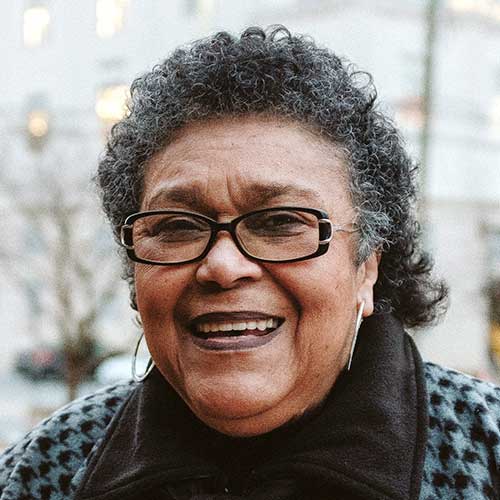2004
2004
Racial profiling and stigmatization
Description
- In August, after being called for a disturbance, Charlottesville police officers shoot and critically wound a man in a Friendship Court apartment.
- Two witnesses say police officers beat the man with batons before they shot him as he yelled for help. Another resident is arrested after telling police officers to stop racial profiling.
- When residents apply for a job and put “Garrett Street” as their address, employers don’t call them back, says Friendship Court Tenant Association President Mary Carey.
- Albemarle County Supervisor Charles S. Martin launches an adult education program in Friendship Court called Urban Vision.
Quote
That fence makes the community think we’re a bunch of criminals down here. These are good people, hard-working people.
— Mary Carey, president of the Friendship Court Tenant Association.
People
What do you remember about the police shooting a man in Garrett Square?
Were the police racially profiling and discriminating against people?
The Reimagining of Friendship Court
INTRO
By
Jordy Yager
The redevelopment of Friendship Court is slated to be the largest new construction of low-income housing undertaken in Charlottesville in more than two decades. The plan alone is groundbreaking, having been directly created by current Section 8 residents in partnership with Piedmont Housing Alliance. City staff calls it the most nuanced and complex plan they’ve ever encountered. It ambitiously attempts to balance promises of zero resident displacement with the city’s broader affordable housing needs, while also calling for hundreds of new, likely higher-income, residents to move in, as residents hope to de-stigmatize the lasting effects of poverty born out of generations of racist government policy and neglect.
This year will be the make-or-break year for Friendship Court’s redevelopment efforts. Millions of dollars in city, federal, and private funding stand between the massive plan and the highly anticipated 2020 groundbreaking. And while the green lights have begun to align and most residents are excited, the plan has its critics — those who call for greater levels of resident autonomy, greater security measures to guard against social and cultural displacement, and greater reparations for past wrongs.
In crafting this project, we’ve tried to tackle all of this and more by separating the longer narratives into five major questions:
Part 1: What is the plan?
Part 2: How did we get here?
Part 3: Does mixed-income housing work?
Part 4: Who does Friendship Court belong to?
Part 5: What’s next?
But we also wanted to give you access to as much of our reporting as possible, so we’ve created a timeline that details the history of this area, dating back 150 years, through the use of more than 130 maps, documents, archived articles, and photographs. Similarly, we wanted you to actually hear each of the two dozen long-form interviews we conducted, and not merely the portions we’ve included in the individual stories. So we’ve included more than 300 audio clips throughout the story: in the articles, the timeline, and on each person’s profile page. Our hope is that with all this, more of the picture will begin to emerge, and that, as we stand ready to make powerful and significant changes in the city, we all can help craft the solutions.
The redevelopment of Friendship Court is slated to be the largest new construction of low-income housing undertaken in Charlottesville in more than two decades. The plan alone is groundbreaking, having been directly created by current Section 8 residents in partnership with Piedmont Housing Alliance. City staff calls it the most nuanced and complex plan they’ve ever encountered. It ambitiously attempts to balance promises of zero resident displacement with the city’s broader affordable housing needs, while also calling for hundreds of new, likely higher-income, residents to move in, as residents hope to de-stigmatize the lasting effects of poverty born out of generations of racist government policy and neglect.
This year will be the make-or-break year for Friendship Court’s redevelopment efforts. Millions of dollars in city, federal, and private funding stand between the massive plan and the highly anticipated 2020 groundbreaking. And while the green lights have begun to align and most residents are excited, the plan has its critics — those who call for greater levels of resident autonomy, greater security measures to guard against social and cultural displacement, and greater reparations for past wrongs.
In crafting this project, we’ve tried to tackle all of this and more by separating the longer narratives into five major questions:
Part 1: What is the plan?
Part 2: How did we get here?
Part 3: Does mixed-income housing work?
Part 4: Who does Friendship Court belong to?
Part 5: What’s next?
But we also wanted to give you access to as much of our reporting as possible, so we’ve created a timeline that details the history of this area, dating back 150 years, through the use of more than 130 maps, documents, archived articles, and photographs. Similarly, we wanted you to actually hear each of the two dozen long-form interviews we conducted, and not merely the portions we’ve included in the individual stories. So we’ve included more than 300 audio clips throughout the story: in the articles, the timeline, and on each person’s profile page. Our hope is that with all this, more of the picture will begin to emerge, and that, as we stand ready to make powerful and significant changes in the city, we all can help craft the solutions.





